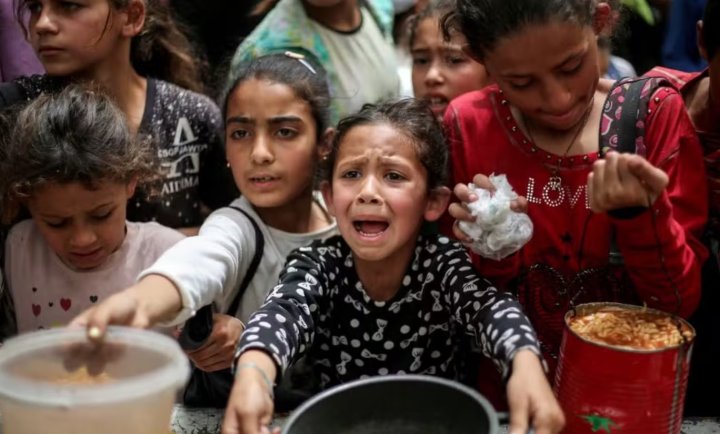
The following text, written by Samidoun Brasil, was originally published in Portuguese at Esquerda Diario, for the public hunger strike against the ongoing Zionist-imperialist genocide and imposed starvation in Gaza and throughout Palestine in Sao Paulo, Brazil, on 27 July 2025.
The Gaza Strip, a territory that before 2023 had never experienced famine, is now standing on the brink of the grave. According to the IPC (International Food Security Phase Classification) report from May 12, 2025, all 2.1 million residents of Gaza are classified at Level 3 of food insecurity; that is, at least one adult in the household repeatedly experiences physical hunger. Among them, 925,000 are at Level 4, where all adults regularly suffer physical hunger, and children in those households do not receive enough caloric intake to sustain their growth. Furthermore, 244,000 people—12% of the total population—are already at Phase 5, where the caloric intake for every member, regardless of age, is insufficient to prevent disease and death in the near term.
It is worth highlighting, among the many crimes against childhood committed by the Zionist entity — the bombed schools, the white phosphorus bombardments, the lands contaminated with D-38 uranium munitions — the total commercial blockade imposed on Gaza by Israel since 2 March 2025. The price of basic goods has skyrocketed by 1,400% in a month; yet markets remain empty. 20% of children between the ages of 6 and 59 months suffer from acute malnutrition. That is, they are unable to ingest sufficient amounts of carbohydrates, proteins, minerals, and vitamins to sustain bodily functions. It’s important to emphasize that in the history of the Palestinian Holocaust, which has lasted 20 months, children in Gaza live not only with chronic malnutrition, but also with chronic food insecurity: enduring two to four months of physical hunger every year, recurrently.
We could list increasingly complex statistical classifications here, but how can data convey the physical exhaustion of hunger? The fatigue of wandering all day through foul-smelling streets (not due to sewage) in search of a single kilogram of flour, baked into eight meager loaves to last the next four days, as reported by journalist Shaimaa Eid, writing from Gaza for the Palestine Chronicle.
Meanwhile, our natural wealth — oil reserves, iron, chromium, and nickel mines, our heritage and rightful property of the masses who build nations — is diverted from social use to fund the slaughter of our fellow peoples. In Brazil, crude oil exports by the state-owned PetroBras grew 44,000% between 2023 and 2025. In fact, the former employer of President Luiz Inácio Lula da Silva, Villares Metals S/A, exports steel directly to Israeli Weapons Industries (IWI) and Israeli Military Industries (IMI), the latter a subsidiary of Elbit Systems. Despite his strong union activism during his time on the board of the Metalworkers’ Union of ABC Paulista, Lula has taken a posture that is, at best, ambiguous regarding the severing of commercial ties with the genocidal colonial state.
A superficial analysis may suggest that the famine now being experienced in Gaza is unprecedented in modern history. However, what is happening in Palestine is a tragic repetition of what has been applied to other countries and territories by a colonialist and imperialist system that has devoured the world for 500 years. As an illustration, who remembers East Timor? A Portuguese colony ceded to Australia (another settler colony) in 1941, and then conquered by the Japanese Empire that same year—a military occupation that killed 70,000 people, or 14.5% of the population at the time. Nine days after gaining independence from Portugal in 1975, East Timor was invaded by Indonesia with U.S. support. That second occupation lasted 24 years and killed approximately one-third of the territory’s population, even accounting for population growth. Today, the average height of men in East Timor is 160.13 cm and of women, 152.71 cm, a result of stunted growth caused by prolonged and deliberate famine during those decades.
And yet… despite this grim past, the Timorese people survived. East Timor is one of the most linguistically diverse countries in the world, with around 26 languages spoken daily. Between animist rituals, the colonial architecture of cathedrals, and countless local legends about the native fauna, dozens of cultures interact dialectically. The state even celebrates two independence days—one from Portugal in 1975, and another from Indonesia in 2002.
So come, comrades, let us abandon these illusions of a “Final Solution.” The occupations of Palestine —Roman, British, and “Israeli” — come and go; the Palestinian people remain. Israel’s plans are delusional, its capacity to carry out its desired occupation is collapsing, and with the deepening genocide, the regime is becoming completely dependent on the United States. Indeed, “Israel” will try to strike, wound, and starve as many Palestinians as possible for as long as it can. And it will fail. But the question that the 2025 Gaza famine leaves for history is this: how long did we allow our governments to let these colonial fantasies persist?
The human cost is immense, but far from being ghosts of a forgotten people, each of the martyrs will become a song of remembrance for men and women yet to be born. As the great Palestinian poet Fadwa Tuqan once wrote:
“We fight with our eyes,
We sow with our hands,
We will see the wheat fill the valley.”

Discover more from Samidoun: Palestinian Prisoner Solidarity Network
Subscribe to get the latest posts sent to your email.




